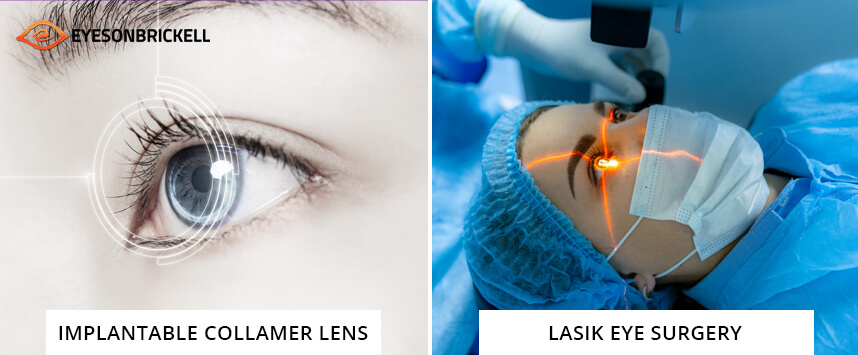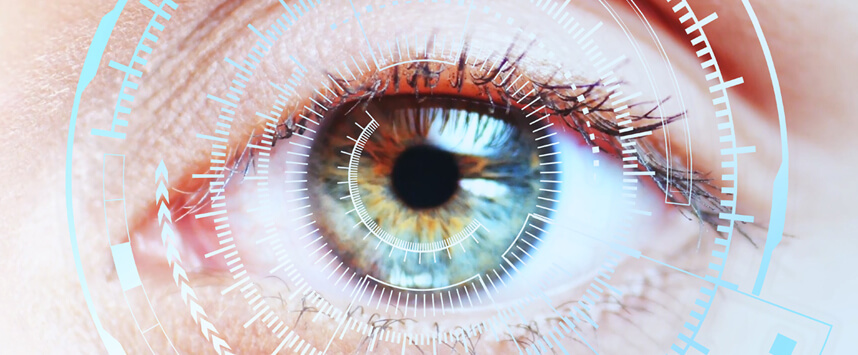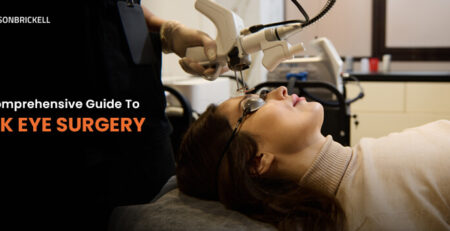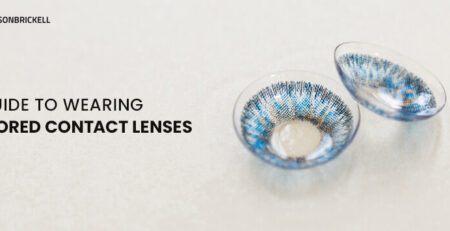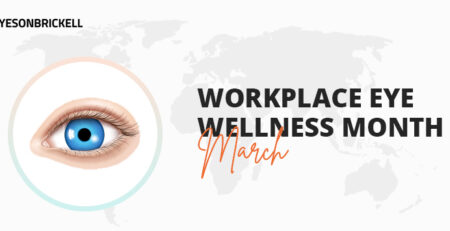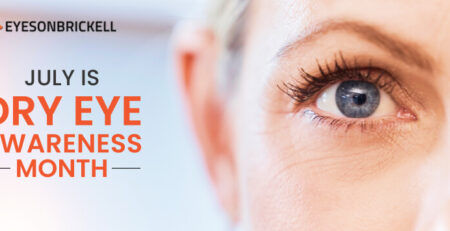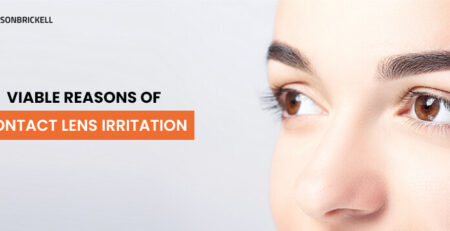ICL vs. LASIK Eye Surgery: A Comprehensive Comparison Guide
ICL vs. LASIK Confused what to choose and why?
Well, clear vision is essential for navigating the world around us, allowing individuals to see clearly and accurately. However, millions of people around the world experience blurry or distorted vision caused by common refractive errors such as nearsightedness, farsightedness, and astigmatism.
Did you know that, according to the American Academy of Ophthalmology, astigmatism, which can be combined with near—or farsightedness, affects roughly one-third of the population?
Although we have access to a wide range of vision correction options, such as contact lenses and glasses. However, in some cases with certain eye conditions, they might not help as much as required. Certain eye conditions, like nearsightedness and farsightedness, require more advanced diagnosis and treatment. In such cases, more advanced diagnosis and treatment may be necessary. This is where surgeries like ICL or LASIK eye surgery come into play, offering superior solutions for enhanced vision and freedom from corrective eyewear.
At Eyes on Brickell, we prioritize providing comprehensive eye care services, leveraging our expertise in eye health. In this guide, we’ll delve into the critical distinctions between LASIK and ICL, explaining how each corrective eye surgery functions, identifying suitable candidates, discussing potential risks, and outlining the benefits of both treatments.
Understanding Vision Correction
Our ability to see things depends on the eye’s functionality. We must first understand the eye’s functionality to understand vision correction better. To see things, the cornea (the clear dome at the front of the eye) and the lens inside the eye work together to bend (refract) light to focus it onto the retina (a light-sensitive layer at the back of the eye). A refractive error occurs when this focusing process isn’t perfect, leading to blurred vision. There are three main types of refractive errors:
- Myopia (Nearsightedness): In this case, the eyeball is too long or the cornea is too curved, causing light rays to focus in front of the retina instead of directly on it. This results in blurry vision for distant objects, while near objects appear clear.
- Hyperopia (Farsightedness): Hyperopia, also known as Hypermetropia, occurs when the eyeball is too short or the cornea is too flat. This causes light rays to focus behind the retina, leading to blurry vision for near objects, while distant objects might be more apparent.
- Astigmatism: When the cornea or lens has an irregular curvature, similar to the shape of a football, this condition is known as Astigmatism. As a result, light rays are not focused into a single point on the retina, causing blurred or distorted vision at all distances.
LASIK and ICL address these refractive errors by reshaping the cornea (LASIK) or introducing an additional lens inside the eye (ICL) to achieve proper light focus on the retina and improve vision. Let’s understand how ICL vs. LASIK treatments work!
ICL vs. LASIK Eye Surgery
LASIK (Laser-Assisted in Situ Keratomileusis)
LASIK is a widely used vision correction procedure that permanently changes the shape of the cornea, the clear dome at the front of the eye. This lets light focus properly on the retina, resulting in sharper vision without glasses or contacts.
Procedure
The procedure of LASIK surgery is divided into the following steps:
- Creating a Corneal Flap: During LASIK, your ophthalmologist (eye surgeon) will first use a particular instrument called a microkeratome or a femtosecond laser to create a thin flap in the outer layer of your cornea. This flap acts like a hinge.
- Reshaping the Cornea: Once the flap is lifted, a computer-controlled excimer laser removes a tiny amount of tissue from the underlying corneal stroma. The laser ablation pattern is customized for your refractive error (nearsightedness, farsightedness, or astigmatism).
- Replacing the Flap: The corneal flap is gently repositioned back into its original place after the laser treatment. The flap naturally adheres to the underlying tissue without stitches.
Suitability
LASIK corrective eye surgery is not suitable for everyone. Here are some factors that determine if you’re a good candidate:
- Corneal Thickness: Your cornea must be thick enough to create a stable flap and safely withstand the laser treatment.
- Refractive Error Range: LASIK can effectively correct a wide range of refractive errors, but there are limitations. Your ophthalmologist will determine if your specific prescription falls within the treatable range.
- Eye Health: You should be free of active eye diseases or infections.
Benefits
Here is the list of benefits of LASIK in Miami:
- Faster Recovery: Most patients experience significant vision improvement within 24 hours, with continued improvement over the following days or weeks.
- Minimal Discomfort: The procedure uses anesthetic eye drops and discomfort is minimal.
- Proven Track Record: LASIK is a well-established procedure with a long history of success and safety.
Possible Risks and Complications
As with any surgery, LASIK has some potential risks and complications. These are relatively uncommon, but it’s essential to be aware of them:
- Dry Eyes are a common temporary side effect that usually resolves within weeks or months. Artificial tears can help alleviate dryness.
- You may experience blurry or halos around lights shortly after surgery.
- In rare cases, the corneal flap may become dislodged or develop irregularities. This can usually be corrected with additional treatment.
ICL (Implantable Collamer Lens)
An ICL, or Implantable Collamer Lens, is a corrective lens permanently implanted inside your eye to improve your vision. Unlike LASIK eye surgery which reshapes your cornea, an ICL acts like an additional focusing lens. It’s made of a biocompatible material called Collamer, which is flexible and similar to natural tissue.
Procedure
ICL eye surgery is typically an outpatient procedure performed with local anesthesia. Here’s a simplified breakdown of the steps:
- Tiny Incision: The surgeon makes a small incision in the white part of your eye (sclera).
- Folding and Insertion: The ICL lens is folded into a tiny size and inserted through the incision.
- Unfolding and Positioning: Once inside your eye, the lens unfolds and is positioned behind your iris (the colored part) and in front of your natural lens.
- No Stitches Needed: Stitches aren’t usually required because the incision is so small.
Suitability
ICL eye surgery might be a good option for you if:
- Your cornea is too thin: LASIK relies on reshaping the cornea, but if it is naturally thin, ICL might be a safer alternative because it doesn’t touch the cornea.
- You have a high refractive error: ICL can effectively correct a broader range of nearsightedness (myopia), farsightedness (hyperopia), and astigmatism compared to LASIK.
- Dry Eyes: If you experience dry eyes, ICL might be a better choice. Since it doesn’t alter the cornea, it might be a better choice if dry eyes are a concern.
Benefits
There are several advantages to consider with ICL:
- Untouched Cornea: Unlike LASIK, ICL leaves your cornea untouched, potentially reducing the risk of complications associated with corneal reshaping.
- Potentially Better Night Vision: Some people experience improved vision after ICL implantation.
- Reversible Procedure: If necessary, your ophthalmologist can remove the ICL.
Possible Risks and Complications
As with any surgery, there are potential risks associated with ICL. These include:
- The procedure involves creating an incision in the eye, which carries a slightly higher infection risk than LASIK.
- ICL corrective eye surgery is generally more expensive than LASIK.
- In rare cases, the ICL can cause a temporary or permanent increase in eye pressure, requiring additional treatment.
Comparison Chart
| Feature | LASIK | ICL |
|---|---|---|
| Procedure Type | Laser reshaping of the cornea | Implantation of a foldable lens behind the iris |
| Suitable For | Mild to moderate myopia, hyperopia or hypermetropia, and astigmatism (corneal thickness permitting) | Cornea remains untouched, potentially better night vision, reversible procedure |
| Benefits | Faster recovery, minimal discomfort, proven track record | Moderate to high myopia, thin corneas, dry eyes |
| Possible Risks & Complications | Dry eyes, temporary vision fluctuations, flap complications (rare) | Increased infection risk, higher cost, potential for increased eye pressure |
| Recovery Time | 1-2 days | Up to a week |
Choosing the Right Procedure- ICL vs LASIK
Before diving into the specifics of LASIK and ICL, it’s essential to understand that vision correction surgery is a personal decision. There’s no “one size fits all” answer; the best procedure depends on your circumstances. Here are some key points to consider:
Factors to Consider
Here are some key factors to consider:
- Corneal Health: LASIK relies on reshaping the cornea with a laser. If your corneas are naturally thin or have pre-existing irregularities, ICL may be a safer alternative. Before you decide, contact Eyes on Brickell for our comprehensive Eye Care Services in Miami!
- Refractive Error: LASIK can effectively correct a wider range of refractive errors, including nearsightedness, farsightedness, and astigmatism. ICL is primarily used to correct nearsightedness (myopia). The severity of your refractive error can also influence the choice – LASIK may not be suitable for high prescriptions.
- Lifestyle: LASIK offers a faster recovery time, making it ideal for individuals who desire a quicker return to their active routines. ICL, on the other hand, may require slightly more post-operative care. Consider your daily activities and how quickly you need to resume them.
- Budget: LASIK is typically the more cost-effective option than ICL. However, some insurance plans may offer partial coverage for vision correction procedures.
Consulting a Qualified Ophthalmologist
Making an informed decision about vision correction surgery requires a comprehensive evaluation by a qualified ophthalmologist, like Dr Antoine Copty. Dr. Copty is a highly trained eye doctor who will assess your needs and recommend the procedure that best suits your unique situation. During the consultation at Eyes on Brickell’s office, Dr. Copty will:
- Conduct a thorough eye examination, including detailed cornea measurements and overall eye health.
- Discuss your medical history and any pre-existing conditions that may impact surgery.
- Review your lifestyle and expectations for vision correction.
- Explain the details of LASIK and ICL procedures, including the benefits and potential risks.
After all the discussions, Dr. Copty will help you determine whether LASIK or ICL treatment suits you. So don’t wait! Book an Appointment at Eyes on Brickell’s office for Eye Care Services in Miami today! Or you can visit us at 1925 Brickell Ave, Suite D301, Miami, Florida, or call us 786-801-1335 to make an appointment!

